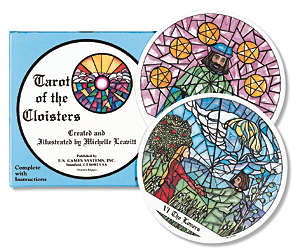Michelle Leavitt's
Tarot of the Cloisters
A Deck Review
I first saw Tarot of the Cloisters in early 1999, when I was searching for
another deck. Since I had only enough money to buy one deck, I left the
Cloisters cards on the shelf. Months later, as I was surfing the web, I
stumbled across a page about Tarot of the Cloisters, and I got curious as to
what I had left behind before. The information included a few pictures of
assorted cards from the deck. I was simply blown away. This is the first
deck in a long time that made me want to buy it just for the images.
What made me skeptical about Cloisters was that it is a round deck, and all
of the round decks I had seen or heard of were highly feminist decks. The
Cloisters deck is not a feminist deck, it is simply round because the images
are designed to mimic stained-glass windows found in cloisters (buildings
adjacent to 12th century cathedrals). At this task, the author has certainly
succeeded, in my estimation. The cards do indeed appear like genuine stained
glass windows and, with time and effort, one could probably make a very
beautiful window based on any of the cards' images.
What surprised me initially, as I have alluded to, was the amount of detail
visible in the scenes despite the heavy black lines which denote where the
pieces of glass fit together. After working with the cards for a while, the
lines seem to fade into the background and leave the scene itself behind. In
some cases the lines actually add to the scenes; many of the Major Arcana
such as The Moon and Judgement actually look better with the lines intact.
The moon in the card of the same name is made of a single piece of "glass"
and it looks very beautiful.
The only thing I dislike about the artwork is the way faces are added to the
characters; they are just one piece of glass added to the set. I realize
that this is how stained-glass faces are done and to leave this out would be
to destroy the theme of the deck. In some cases, such as on The Moon, this
effect is hauntingly beautiful, but this varies in quality from card to card.
The face of the woman on the Star, for example, blends in perfectly with the
scene. The face of the child on the Sun certainly does not, because of its
soft colors and round contours amidst jagged lines and fiery hues. The man
on the Nine of Cups looks downright ugly for similar reasons.
The booklet acompanying the deck is nothing to write home about; the meanings
are generally traditional and very tersely worded. It has an interesting
relationship spread which I may try sometime, though. There is obviously no
problem with using round cards in traditional spreads because the Celtic
Cross is another spread described. Leavitt additionally gives astrological
correspondences as a way to choose a Significator, but the correspondences
she uses are not the generally accepted ones (Chariot and Temperance are
switched, and Judgement replaces Death under Scorpio). Some students of
astrology or beginners to Tarot could find this confusing.
 This deck is apparently somewhat rare, so collectors might want to snatch one
before it goes out of print. I think the only reason I found one at a local
bookstore was because Michelle Leavitt, the deck's author, is originally from
my area (Fredericton, New Brunswick, Canada) and she sends copies here
occasionally. Though not everyone will like Tarot of the Cloisters, those
who do like it will like it very much.
This deck is apparently somewhat rare, so collectors might want to snatch one
before it goes out of print. I think the only reason I found one at a local
bookstore was because Michelle Leavitt, the deck's author, is originally from
my area (Fredericton, New Brunswick, Canada) and she sends copies here
occasionally. Though not everyone will like Tarot of the Cloisters, those
who do like it will like it very much.
Copyright 2000 James Rioux
 This deck is apparently somewhat rare, so collectors might want to snatch one
before it goes out of print. I think the only reason I found one at a local
bookstore was because Michelle Leavitt, the deck's author, is originally from
my area (Fredericton, New Brunswick, Canada) and she sends copies here
occasionally. Though not everyone will like Tarot of the Cloisters, those
who do like it will like it very much.
This deck is apparently somewhat rare, so collectors might want to snatch one
before it goes out of print. I think the only reason I found one at a local
bookstore was because Michelle Leavitt, the deck's author, is originally from
my area (Fredericton, New Brunswick, Canada) and she sends copies here
occasionally. Though not everyone will like Tarot of the Cloisters, those
who do like it will like it very much.